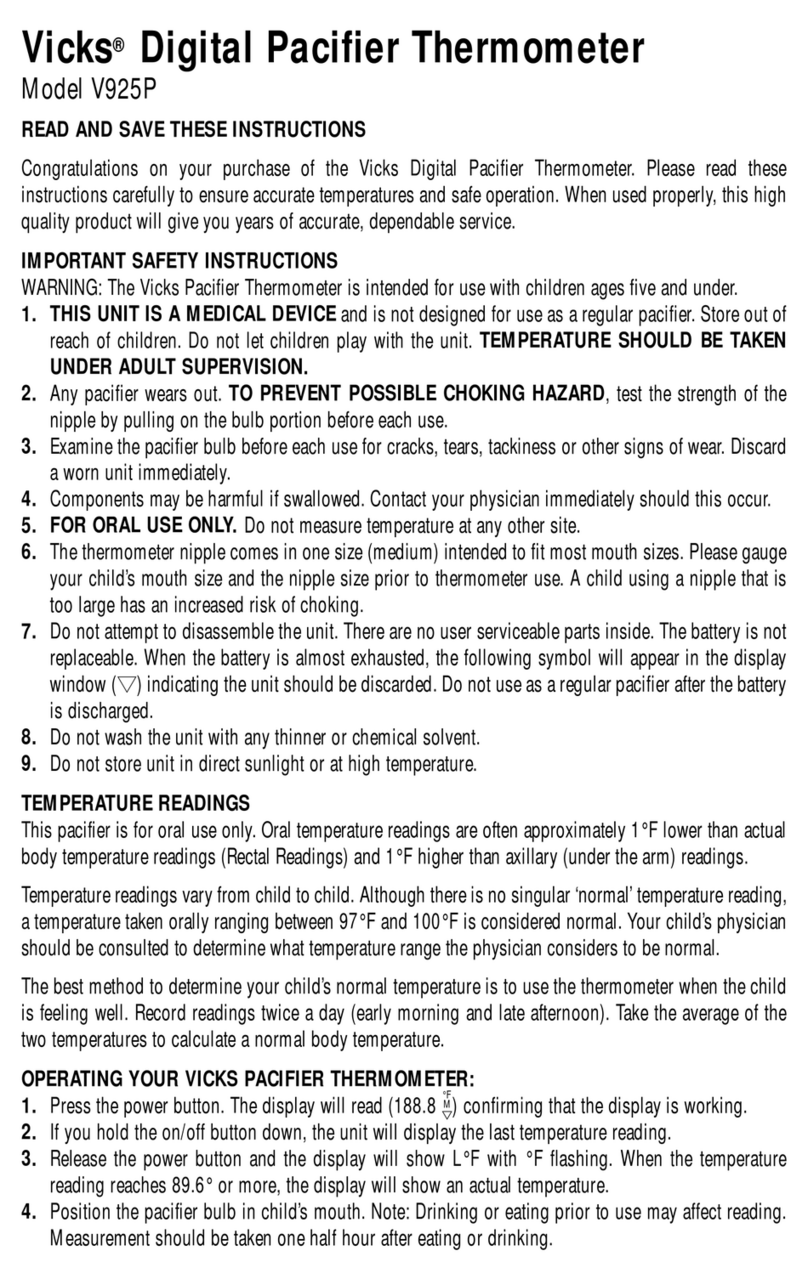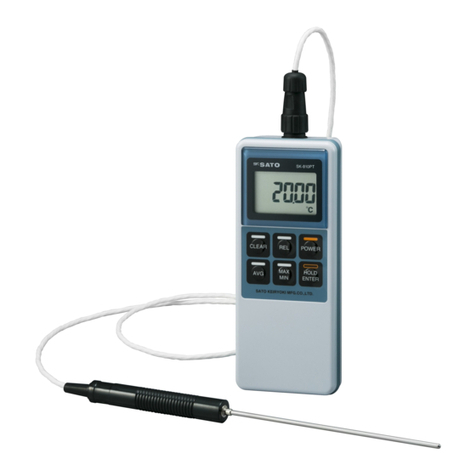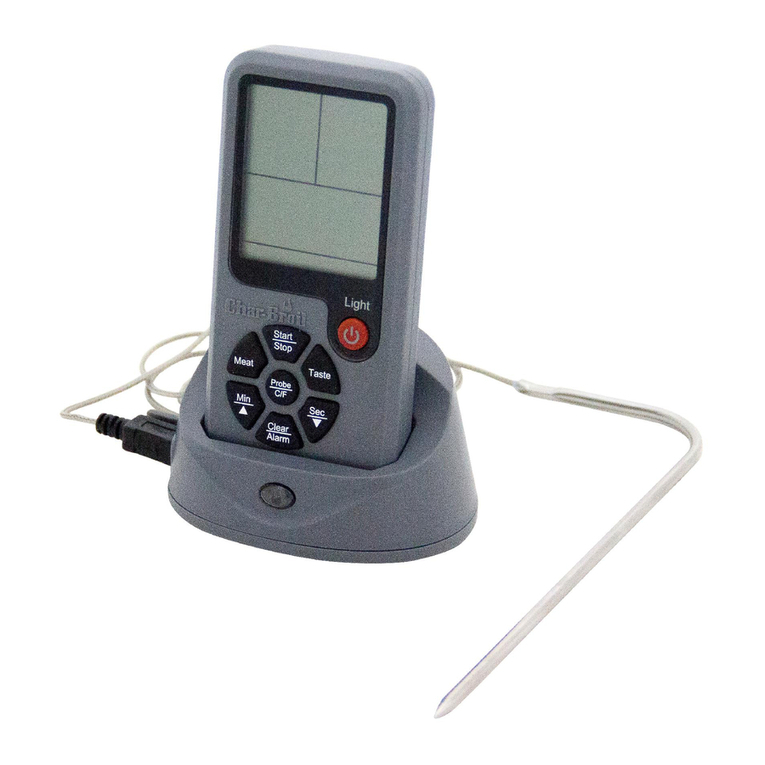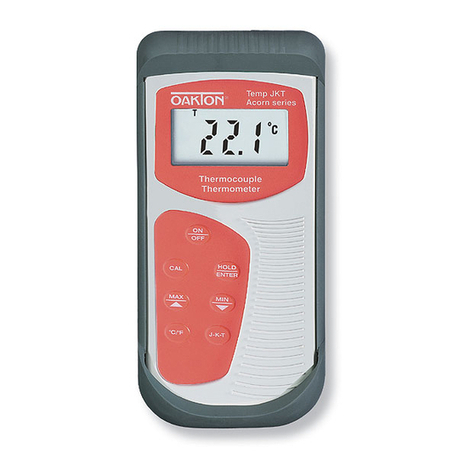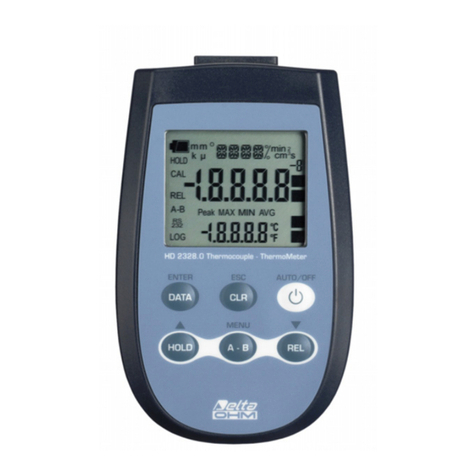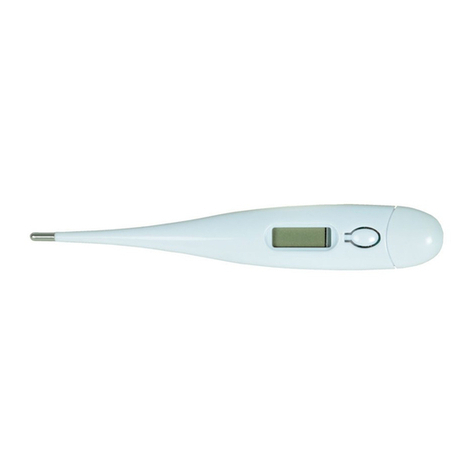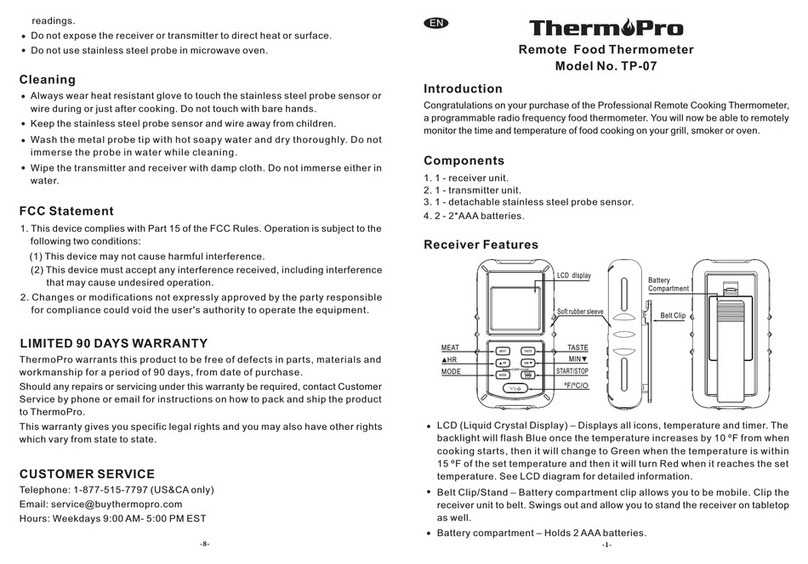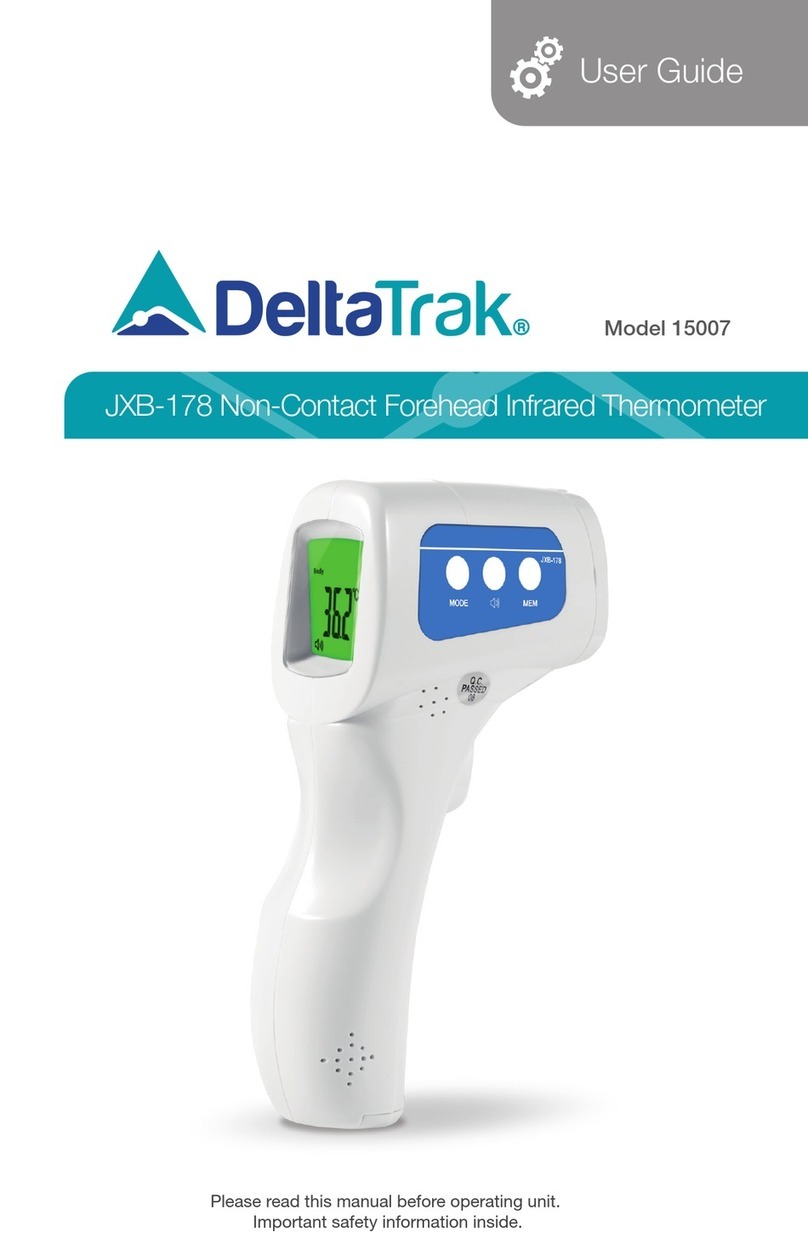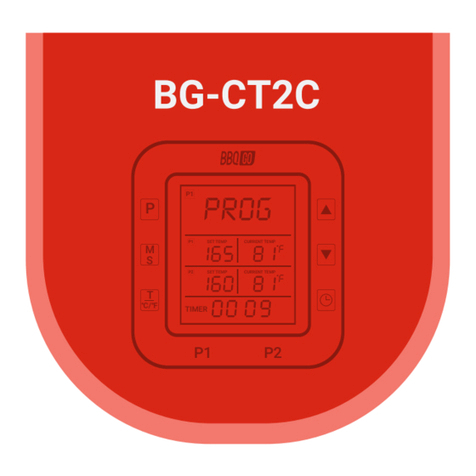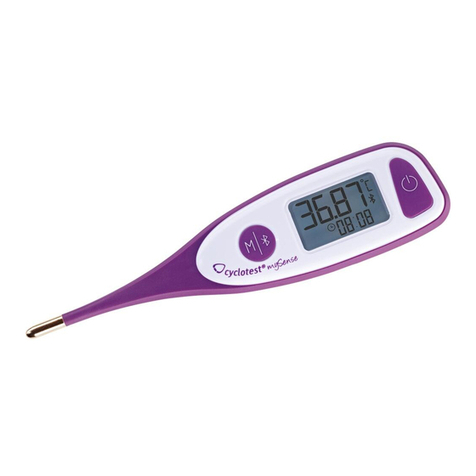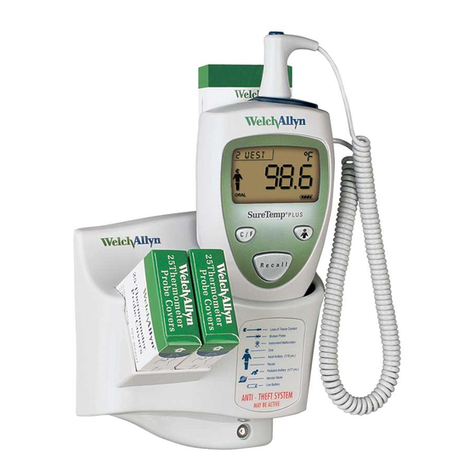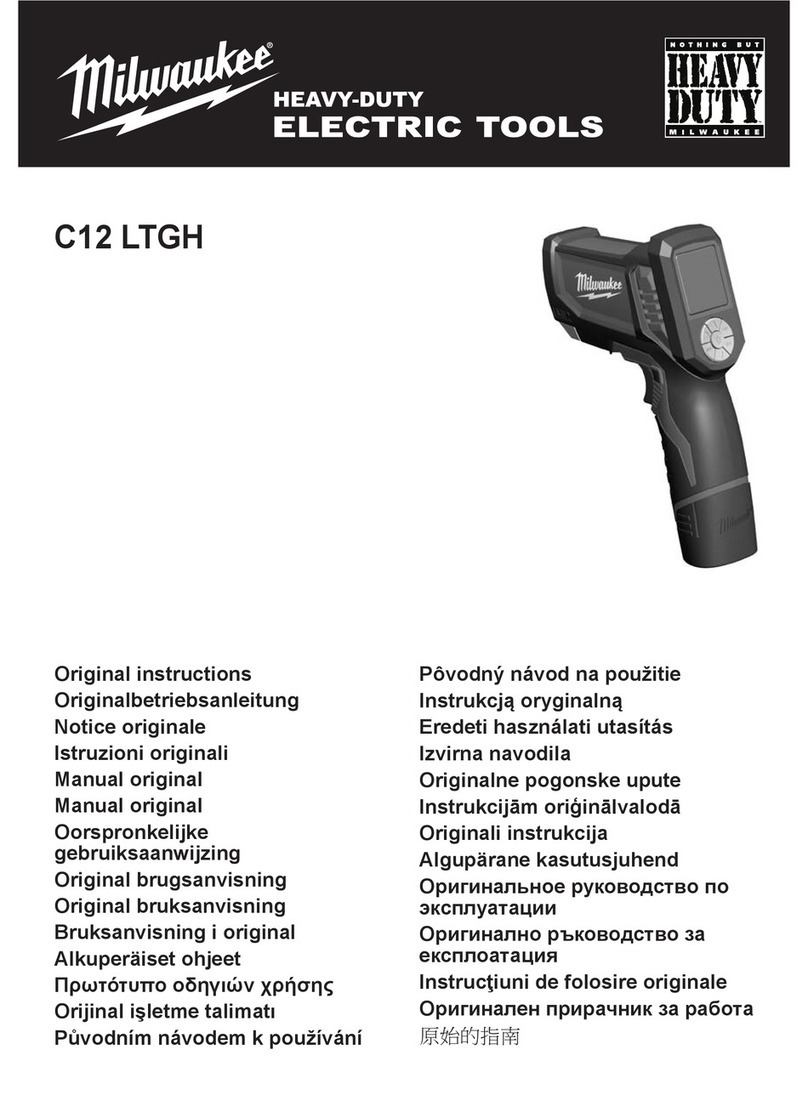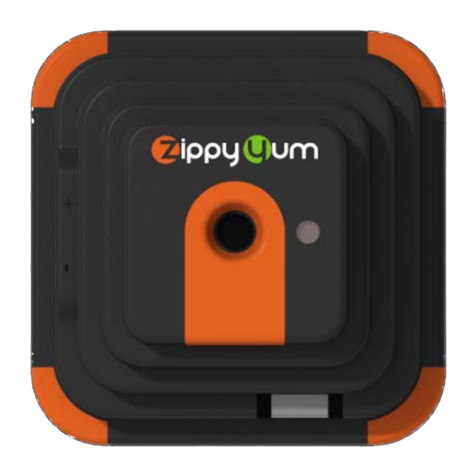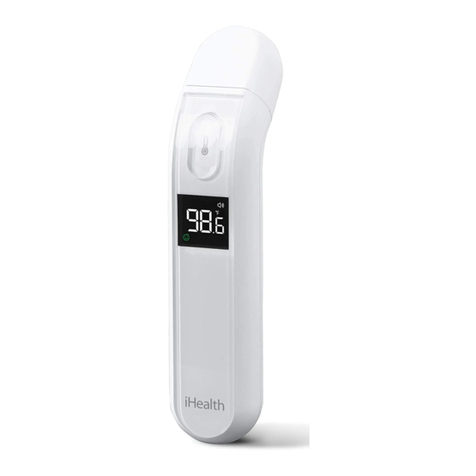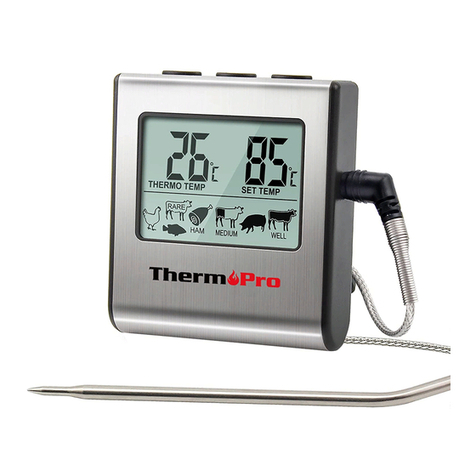MedNet DT-20B User manual

User’s Manual
Electrical Thermometer
Models:DT-20B、DT-20、DT-10B、DT-10

2
1. The Basics
This manual contains the instructions necessary to operate the
product safely and in accordance with its function and intended
use. Observance of this manual is a prerequisite for proper
product performance and correct operation and ensures patient
and operator safety. Professionals, non-professionals, and patients
can operate medical device in accordance with the instructions.
1.1 Safety
Get medical attention if you have high fever or prolonged
fever, especially young children. Read carefully and follow
the instructions to ensure accurate temperature
measurement.
Keep out of reach of unsupervised children. Components
may be harmful if swallowed.
This device is designed for oral, rectal, or axillary use only.
Please note that temperature measuring are affected by many
factors, including strong physical activity before the test,
drinking hot or cold drinks, and measurement methods.
Avoid taking temperature for 30 minutes after physical
exercise, bathing, dining, or drinking hot or cold beverages.
Stop using the thermometer if it operates erratically or if
the display malfunctions.
Allow the thermometer to warm naturally to room
temperature before using. Performance may be affected if
operated or stored outside stated temperature and humidity
ranges or if the patient's temperature is below the ambient
(room) temperature.
Please note that the use of this product in high temperature
or humidity may cause inaccurate temperature measurement

3
results.
Do not boil, bite, bend, drop, or disassemble the
thermometer.
Do not share the thermometer with more than one person
without disinfection, or it may cause cross-infection.
Do not try to sterilize by immersing the thermometer head in
alcohol or hot water (water temperature exceeds 50°C).
Do not use force to squeeze the product. If the appearance is
damaged, stop using it immediately.
Precision components are used in the construction of this
device. Extremes in temperature, humidity, direct sunlight,
shock or dust should be avoided.
Clean the device with a dry, soft cloth or a cloth dampened
with water and a neutral detergent. Never use alcohol,
benzene, thinner or other harsh chemicals to clean the
device .
Measurements may be distorted if the device is used close to
television, microwave oven, cellular telephone, X-ray or
other devices with strong electrical fields.
Used equipment, parts and battery are not treated as ordinary
household waste, and must be disposed of according to
the applicable local regulations.
Please keep the thermometer close to the skin when
measuring. If it is loose, the temperature measurement
result could be inaccurate.
During the measurement, please avoid strenuous
activity,eating or strong emotional ups and downs, and use
this product in a relatively stable indoor environment.
When reusing the device, confirm that the device is clean.
Do not modify the device. It may cause accidents or damage
to the device.

4
Do not self-diagnose the measurement results and start
treatment by yourself. Always consult your doctor for
evaluation of the results and treatment.
Adults are required to shaving the skin before
measuring their temperature. Make sure that the skin that is
in contact with the thermometer is flat and wrinkle-free.
Do not use the device where flammable gases such as
anesthetic gases are present. It may cause an explosion.
Please note that the use of this product in high temperature
or humidity may cause inaccurate temperature measurement
results.
The effective wireless transmission distance of this
product in a barrier-free environment is 10 meters. If the
distance exceeds this limit, this product may not work
properly. Please use this product in the effective wireless
transmission distance.
The battery inside this product cannot be replaced.
All the illustrations provided in this manual are for
reference only.
Please refer to the actual product.
When the device is abnormal or damaged, please do not
use the device again, you can contact the manufacturer.
If necessary, to obtain information on the use and
maintenance of the equipment or to report abnormal
conditions, please contact the manufacturer.

5
2. Introduction
2.1 Intended Use
The product is used to measure body temperature and pulse rate in
the home and in the medical sector.
2.2 Contraindications
Those who are allergic to stainless steel or PC plastic should not
use this product.
2.3 Symbols
Symbol
Meaning
Application part type BF
Manufacturer
CE0197
In conformity with MDR 2017/745
European Representative
Symbol for “ENVIRONMENT PROTECTION –
Waste electrical products should not be disposed of
with household waste. Please recycle where
facilities exist. Check with your local authority or
retailer for recycling advice”.
IP22
Against ingress of solid foreign objects ≥12.5mm
diameter, Against dripping(15° tilted)
Follow operating instructions

6
2.4 About the product
Product name: Electrical Thermometer
Software release version:V1
Product model:
Model and Configuration see the table below.
Function
DT-10
DT-10B
DT-20
DT-20B
Tempera
ture
●
●
●
●
Pulse
rate
△
△
●
●
Buetooth
×
●
×
●
Color
Blue
White
Blue
White
Note: ● Indicates that this function is available, × indicates that this function is not
available, △indicates optional function.
1
3
4
5
2

7
1. Temperature Key
Short press the power on, and drip a sound, long press 3 seconds
off;
Press to start/stop temperature measurement.
2. Pulse rate Key
Short press the power on, and drip a sound, long press 3 seconds
off;
Press to start/stop pulse rate measurement.
3. Display Screen
It can visually display the temperature or pulse measurement
results.
4. Probe Tip (Temperature sensor)
By touching it, the temperature can be measured.
5. Pulse sensor
Pulse rate can be measured by touching it.
Note: Type DT-10 and DT-10B have no pulse rate function.

8
3. Using the thermometer
3.1 Charge the Battery
1. The device has a built-in lithium battery, which can be c
harged for repeated use;
2. The user connects one end of the USB cable to the powe
r adapter, and inserts the other end into the host USB chargi
ng interface for charging. After the power is connected, char
ging animation will be displayed;
3. After charging, rest the screen and shut down;
Note 1: Bluetooth is turned on when charging, and the host
is in the power-on state. However, temperature and pulse r
ate measurement are not supported when charging.
Note 2: The device cannot be used during charging.When ch
arging, you must use a class Ⅱ adapter conforming to IEC/
EN 60601-1, and the output is DC 5V 1A. If it is not follo
wed, there may be a risk of electric shock.
3.2 Before Measurement
1. Clean and disinfect the thermometer before use, and take a
proper rest before measurement. If you feel unwell, you should
consult your doctor immediately in addition to the measurement
results of this device.
2. Please press the temperature/pulse button to start the product.
3. After starting up, the record is displayed on the screen,
indicating that the value is the recent measured historical data.
When the power is less than 3%, the display screen will prompt
when starting up, and it will automatically shut down after 2

9
seconds.
3.3 Measurement
Please follow the instructions below after starting the machine.
Measuring oral temperature
1. With your mouth open, put the temperature measuring head
under your tongue.
2. Close your lips gently around the thermometer.
3. Remain motionless, until a drops dripping sound (it takes about
20 seconds), the equilibrium temperature for prediction of the
human body, if you want to get more accurate temperature value,
should continue to measuring temperature, the thermometer will
timely update the temperature display, until the actual human
body equilibrium temperature is reached (measured temperature
balance), and the process of oral general need 3-5 minutes.
Measuring axillary temperature
1. Put the temperature measuring head securely in your armpit.
2. Hold your arm down tightly at your side.
3. Remain motionless, until a drops dripping sound (it takes about
20 seconds), the equilibrium temperature for prediction of the
human body, if you want to get more accurate temperature value,
should continue to measuring temperature, the thermometer will
timely update the temperature display, until the actual human
body equilibrium temperature is reached (measured temperature
balance), and the process of oral general need 5-10 minutes.
Measuring rectal temperature
1. Lubricate the probe tip with a water-soluable jelly for easier
insertion;
2. do not use petroleum jelly,as it may cause an inaccurate
reading. Gently insert the probe tip no more than 1/2 inch into the
rectum.

10
3.4 After Measurement
1. When the buzzer emits a beep sound(Beep-short sound) , it
indicates that the temperature measurement is finished. The
display "°C/℉" stops blinking, and the displayed temperature
value is the result of the current body temperature.
2.Turn off the thermometer: press and hold (> 0.5 seconds) to
switch the thermometer off.
3.If no operation is performed for more than 3 minutes, the
thermometer will automatically turn off. It is recommended to
manually turn off the thermometer after the temperature
measurement to extend the battery life.
3.5 Pulse measurement
1. Place your finger on the pulse sensor and gently touch the
pulse sensor for 30 seconds.
2. After the finger continues to contact the pulse rate probe for 10
seconds or more, the finger leaves the pulse rate probe to display
the average pulse rate. At this time, the measurement results do
not flicker, but emit drip-drip sound to save the data.
3. The measurement will automatically end after 1 minute. At this
time, the measurement results will not flicker, but emit three
beeps to save the data.
Note 1: Do not press the device too tightly against the skin as this
may cause measurement errors.
Note 2: The pulse rate measurement range is 40Bpm-200Bpm.
When the measured value is not within this range, the heart icon
will flash and the pulse rate will be displayed. There is no

11
indicator light, data will not be saved, and the voice will prompt
the long drop for 3 seconds.
Note 3: User's finger was detected touching the pulse probe.
Mode switching is not allowed.
3.6 Data storage
1. The host can save a total of 60 sets of data (pulse rate 30 +
temperature 30).
2. During the measurement process, temperature and pulse rate
will be stored in the host machine. Users can export the stored
data through Bluetooth or device interface.
Steps for data export by Bluetooth method:
It automatically turns on Bluetooth broadcast when the device is
turned on, which supports users to transmit the host data of the
thermometer to mobile devices (mobile phone /iPad) through
Bluetooth communication for viewing and storage.
(1) Name of Bluetooth broadcast: Model + last four SN codes,
such as DT-20T 8888
(2) Bluetooth connection mechanism: when the Bluetooth
function and APP are opened at the same time,APP will
automatically search and display the product model and SN
number. Click the host with the corresponding Bluetooth
broadcast name on APP to automatically connect.
(3) Data transmitted includes: Time information Power
information Pulse rate/Body temperature measurement data
Note :DT-10 and DT-20 are wired without Bluetooth function
Steps to realize data export:
1) Connect the small-end interface of the data cable to the
charging interface of the thermometer.
2) Connect the other end of the data cable to the USB interface of
the PC .
3) Implemented data export according to the instructions of the
PC.

12
Note: The data cable is a dedicated cable, please purchase
additionally.
3.7 Time Management
1. The device supports Real-Time Clock function, so the device
Clock will work correctly when the host is powered.
2. Time will be lost after absolute shutdown and then boot up
after absolute shutdown.
3. The host time will become the time stored by the hardware on
the host.
4. Cleaning and Disinfecting
Do not use corrosive detergent to clean the unit.
Clean and disinfect the thermometer before and after each use.
4.1Cleaning Process
Wipe probe with a cloth dipped in a disinfectant solution such as
70% isopropyl (rubbing) alcohol or soap and water. Rinse off
disinfectant residue.
4.2Care and Storage
• Do NOT drop or crush; this device is not shock proof.
• Do NOT dismantle or modify device.
• Do NOT store the device in an extreme environment with direct
sunlight or high temperatures.
• Store the unit in the protective case while not in use.

13
5. Trouble Shooting
Problem
Possible Cause
Recommended
Action
Can not boot
Very low battery
Please charge it
according to the
instruction
The ambient temper
ature exceeds 40℃
or below 5℃.
Please use within
the working
environment
temperature range
(5℃-40℃)
The monitor
cannot be
connected to
other devices
Other devices have
Bluetooth turned off
Turn on the
devices Bluetooth
from the setting
menu.
Other devices don’t
support the Bluetooth
4.0 BLE
Change to a
compatible one.
Inaccurate
measured value
The temperature
measuring
heads are placed in
different
positions, resulting in
different readings.
Check whether the
thermometer is
placed in the
correct
position as
described
in “Using the
thermometer”.
Thermometer moves
while
measuring
temperature.
The measured
position is
not kept closed while
the
temperature
measurement

14
is being performed.
The device has not
been placed for more
than 30 minutes from
the colder
environment to the
measuring
environment.
Measurements
should be taken
before they are left
in the measuring
environment for
more than 30
minutes.
The device has not
been placed for more
than 30 minutes from
the warmer
environment to the
measuring
environment.
Measurements
should be taken
before they are left
in the measuring
environment for
more than 30
minutes.
The measurement
temperature exceeds
43.9℃ or below
30℃.
Please use within
the measuring
temperature range
(30℃43.9℃)
6. Accessories
Model
Description
540-00240-00
MICRO USB charge cable

15
7. Specifications
Classifications
EC Directive
MDR, 2017/745
RED, 2014/53/EU
ROHS 2.0, 2011/65/EU
Degree protection against
electrical shock
Type BF
Environmental
Item
Operating
Storage
Temperature
5 to 40°C
-20 to 50°C
Relative humidity
(noncondensing)
15% to 85%
15% to 85%
Barometric
700 to 1060 hPa
700 to 1060 hPa
Degree of dust & water
resistance
IP22
Physical
Size
147mm× 24mm ×11.3mm(main unit)
Weight
Less than 20 g (main unit)
Wireless connectivity
Built-in Bluetooth 4.0 BLE
Expected service life
5 years
Power Supply
Charge input
Micro USB, DC4.5V-5.5V
Battery type
Rechargeable lithium-polymer battery
Battery life
Temperature mode: no less than 9 hours
(full)
Pulse rate mode: not less than 10 hours (full
mode)
Charge time
2~3 hours.

16
Temperature measurement
Measurement method
Direct mode
Measurement site
Mouth,Axilla,Rectum
REFERENCE BODY
SITE
Mouth,Axilla,Rectum
Temperature Unit
Celsius(℃)or Fahrenheit(℉)
Temperature range
32.0 – 43.9℃(89.6-111.0℉)
Measurement accuracy
Less than 35.8℃, ±0.3℃.(Less than 96.4℉,
±0.5℉.)
35.8℃ to less than 37℃,±0.2℃.(96.4℉ to
less than 98.0℉,±0.3℉.)
37.0℃ to 39.0℃, ±0.1℃.(98.0℉ to
102.0℉, ±0.2℉.)
Greater than 39.0℃ to
41.0℃,±0.2℃.(Greater than 102.0℉ to
106.0℉,±00.3℉.)
Greater than 41.0℃,±0.3℃.(Greater than
106.0℉,±0.5℉.)
Pulse Rate measurement
Pulse Rate range
40 to 200 bpm
Pulse Rate accuracy
±2 bpm or ±2%, whichever is greater
Bluetooth RF
Frequency range
2.402 – 2.480 GHz
Max RF power
-10 dBm

17
8. Electromagnetic Compatibility
The device meets the requirements of EN 60601-1-2.
Warnings and Cautionary Advices
Using accessories other than those specified in this manual
may result in increased electromagnetic emission or
decreased electromagnetic immunity of the equipment.
The device or its components should not be used adjacent to
or stacked with other equipment.
The device needs special precautions regarding EMC and
needs to be installed and put into service according to the
EMC information provided below.
Other devices may interfere with this device even though
they meet the requirements of CISPR.
When the inputted signal is below the minimum amplitude
provided in technical specifications, erroneous
measurements could result.
Portable and mobile communication equipment may affect
the performance of this device.
Other devices that have RF transmitter or source may affect
this device (e.g. cell phones, PDAs, and PCs with wireless
function).
Guidance and Declaration - Electromagnetic Emissions
The device is intended for use in the electromagnetic environment specified below. The
customer or the user of the device should assure that it is used in such an environment.
Emission tests
Compliance
Electromagnetic environment - guidance
RF emissions CISPR 11
Group 1
The device uses RF energy only for its
internal function. Therefore, its RF
emissions are very low and are not likely to
cause any interference in nearby electronic
equipment.
RF emissions CISPR 11
Class B
The device is suitable for use in all
establishments, including domestic
establishments and those directly connected
to the public low-voltage power supply
network that supplies buildings used for
domestic purposes.
Harmonic emissions
IEC61000-3-2
Class A
Voltage Fluctuations /
Flicker Emissions IEC
61000-3-3
Complies

18
Guidance and Declaration - Electromagnetic Immunity
The device is intended for use in the electromagnetic environment specified below. The
customer or the user of the device should assure that it is used in such an environment.
Immunity test
IEC60601 test
level
Compliance
level
Electromagnetic
environment - guidance
Electrostatic
discharge (ESD)
IEC 61000-4-2
± 8 kV contact
± 2 kV,± 4 kV,
± 8 kV ,± 15kV
air
± 8 kV contact
± 2 kV,± 4 kV,
± 8 kV,
± 15kV
air
Floors should be wood,
concrete
or ceramic tile. If floors
are
covered with synthetic
material,
the relative humidity
should be at
least 30 %.
Electrical fast
transient/burst
IEC 61000-4-4
± 2 kV for power
supply lines
± 1 kV for
input/output lines
± 2 kV for
power
supply lines
± 1 kV for
input/output
lines
Mains power quality
should be that of a typical
commercial or hospital
environment.
Surge
IEC 61000-4-5
± 1 kV line(s) to
line(s)
± 2 kV line(s) to
earth
± 1 kV line(s)
to
line(s)
± 2 kV line(s)
to
earth
Voltage dips, short
Interruptions and
Voltage variations
on power supply
input lines
IEC 61000-4-11
<5 % UT
(>95 % dip in UT)
for 0.5 cycle
40 % UT
(60 % dip in UT)
for 5 cycles
70 % UT
(30 % dip in UT)
for 25 cycles
<5 % UT
(>95 % dip in UT)
for 5 s
<5 % UT
(>95 % dip in
UT)
for 0.5 cycle
40 % UT
(60 % dip in
UT)
for 5 cycles
70 % UT
(30 % dip in
UT)
for 25 cycles
<5 % UT
(>95 % dip in
UT)
for 5 s
Mains power quality
should be that of a typical
commercial or hospital
environment. If the user
of our product requires
continued operation
during power mains
interruptions, it is
recommended that our
product be powered from
an uninterruptible power
supply or a battery.
Power frequency
(50/60 HZ)
magnetic field
IEC 61000-4-8
3 A/m
3 A/m
Power frequency
magnetic fields should be
at levels characteristic of
a typical location in a
typical commercial or
hospital environment.
Note: UTis the AC mains voltage prior to application of the test level.
Guidance and Declaration - Electromagnetic Immunity

19
The device is intended for use in the specified electromagnetic environment. The customer
or the user of the device should assure that it is used in such an environment as described
below.
Immunity
test
IEC60601
test level
Complian
ce level
Electromagnetic environment - guidance
Conduced
RF
IEC61000-4-
6
3 Vrms
150 kHz to
80 MHz
outside
ISM bands
3 Vrms
150 kHz to
80 MHz
outside
ISM bands
Portable and mobile RF communications
equipment should be used no closer to any
part of the system, including cables, than
the recommended separation distance
calculated from the equation appropriate for
the frequency of the transmitter.
Recommended separation
distances:
Pd 2.1
Radiated RF
IEC61000-4-
3
3 V/m 80
MHz to
2.5 GHz
3 V/m 80
MHz to
2.5 GHz
Recommended separation distances:
80 MHz~800 MHz:
Pd 2.1
800MHz-2.5GHz:
Pd 3.2
Where, Pis the maximum output power
rating of the transmitter in watts (W)
according to the transmitter manufacturer
and dis the recommended separation
distance in meters (m).
Field strengths from fixed RF transmitters,
as determined by an electromagnetic site
survey a, should be less than the compliance
level in each frequency range b.
Interference may occur in the vicinity of
equipment
marked with the
following
symbol:
Note 1: At 80 MHz to 800 MHz, the separation distance for the higher frequency range
applies.
Note 2: These guidelines may not apply in all situations. Electromagnetic propagation is
affected by absorption and reflection from structures, objects and people.
aField strengths from fixed transmitters, such as base stations for radio (cellular/cordless)
telephones and land mobile radios, amateur radio, AM and FM radio broadcast and TV
broadcast cannot be predicted theoretically with accuracy. To assess the electromagnetic
environment due to fixed RF transmitters, an electromagnetic site survey should be
considered. If the measured field strength in the location in which the device is used
exceeds the applicable RF compliance level above, the device should be observed to verify
normal operation. If abnormal performance is observed, additional measures may be
necessary, such as re-orienting or relocating the device.
bOver frequency range 150kHz to 80MHz. For Resp field strength should be less than
1V/m.

20
Recommended separation distances between portable and mobile RF communications
equipment and the device
The device is intended for use in an electromagnetic environment in which radiated RF
disturbances are controlled. The customer or the user of the device can help prevent
electromagnetic interference by maintaining a minimum distance between portable and
mobile RF communications equipment (transmitters) and the monitor as recommended
below, according to the maximum output power of the communications equipment.
Rated max.
output power
of transmitter
(W)
Separation distance according to frequency of the transmitter (m)
150 kHz - 80 MHz
Pd 2.1
80 MHz - 800
MHz
Pd 2.1
800 MHz - 2.5
GHz
Pd 3.2
0.01
0.12
0.12
0.23
0.1
0.38
0.38
0.73
1
1.20
1.20
2.30
10
3.80
3.80
7.30
100
12.00
12.00
23.00
For transmitters rated at a maximum output power not listed above, the recommended
separation distance d in metres (m) can be estimated using the equation applicable to the
frequency of the transmitter, where P is the maximum output power rating of the transmitter
in watts (W) according to the transmitter manufacturer.
Note 1: At 80 MHz and 800 MHz, the separation distance for the higher frequency range
applies.
Note 2: These guidelines may not apply in all situations. Electromagnetic propagation is
affected by absorption and reflection from structures, objects and people.
This manual suits for next models
3
Table of contents
